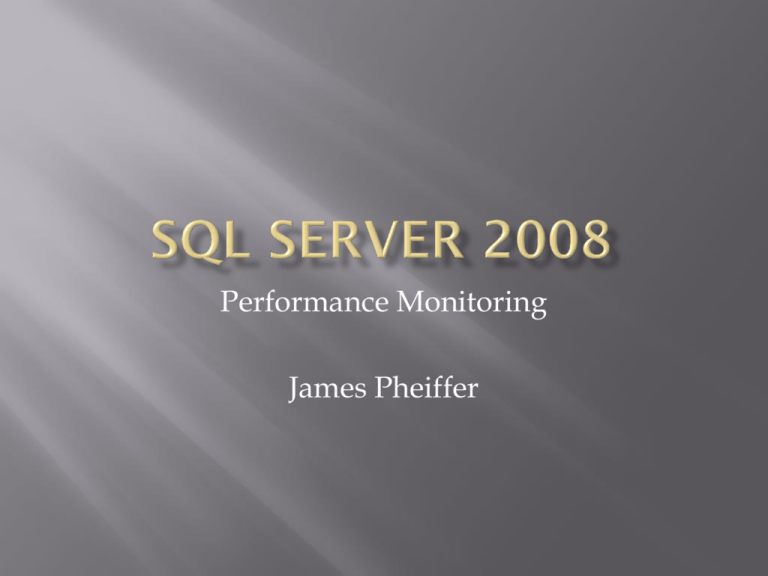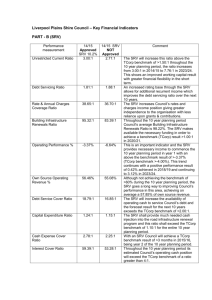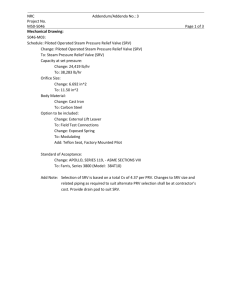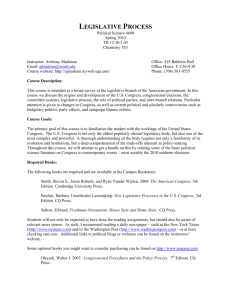SQL User Group PSSDiag Presentation (Server
advertisement

Performance Monitoring James Pheiffer Introduction Performance Monitoring PSSDiag SQLioSim PAL SQL Nexus Internals Viewer Scenario James Pheiffer GijimaAST Intranet Developer SharePoint 2003 BCX MOSS 2007 Microsoft Senior Consultant (MOSS) PFE (SQL and MOSS) SQL Server 2008 DMV’s PSSDiag SQLioSim PAL SQL Nexus Internals Viewer Out of the box with SQL Server 2008 Examples are: Performance Statistics Event Class sys.dm_exec_query_stats sys.dm_exec_procedure_stats sys.dm_exec_trigger_stats sys.dm_tran_locks Holding Locks sys.dm_clr_appdomains sys.dm_clr_loaded_assemblies sys.dm_clr_properties sys.dm_clr_tasks sys.dm_exec_cached_plans sys.dm_exec_requests sys.dm_os_memory_clerks Additional DMV’s PSSDiag is a culmination of SQLDiag (SQL 2005), BPA, DMV’s, Perfmon, SQL Logs etc. Analysis Services Backup a DB Clone DB Stats Cluster Info DB Mail DB Mirroring Delete Old Trace Files Full Text Search Linked server Configuration Merge Replication Missing Perfmon Counters MS info OS Drivers Replication Reporting Services Security Service Broker SQL 2008 Backup MDW SQL 2008 Perf Stats SQL Backup Restore SQL Base SQL Best Practices SQL Blocking SQL Dumps SQL Memory Error SQL Setup SQL Agent SQL Mail PSSDiag captures SQL Specific information Configured in a configuration UI Resulting file is zipped into a self extracting PSSD.exe file PSSDiag.exe needs to be run physically on the SQL server It needs to be run on each node if the SQL environment is clustered It can be run remotely too many scripts cannot be executed Small percentage in loss of performance while PSSDiag is running Therefore PSSDiag should be run just before issue is replicated allowing you to capture the issue Depending on the PSSDiag configuration, the output files can become quite large especially when running Perfmon for long periods of time Current System State srv_TLIST.TXT srv_Running_Services.TXT srv_PROCESS.* srv_IMAGE_FILE_EXEC_OP_REG.TXT SQL srv_SQL(x86)FILES.* srv_SQLFILES.* srv_SQLRIGHTS.TXT srv_SetupLogs_* srv_SchedLgU.Txt srv_OLAP_*_FILES.* Cluster srv_CLUSTERFILES.* srv_WLBS.TXT srv_CLUSTERINFO.TXT srv_CLUSTER_REGISTRY.HIV srv_CLUSTER_cluster.log srv_CLUSTER_chkdsk* srv_CLUSTER_CLUSMPS.TXT I/O srv_FIBRE_CHANNEL_INFO.TXT srv_FILTERDRIVERS.TXT “tlist -t” output NET START output current running processes and their loaded DLLs Image File Execution Options reg key files in Program Files(x86)\Microsoft SQL Server files in Program Files\Microsoft SQL Server user rights needed for SQL services (showpriv) SQL 2000/2005 setup logs Task Scheduler log (for cluster setup issues) Analysis Services files files in C:\Windows\Cluster WLBS config info cluster.exe output (resources, quorum), clust reg HKLM\Cluster cluster log chkdsk output clusmps.exe output fcinfo.exe output fltrfind.exe output Misc srv_IE*.TXT srv_MISC.TXT srv_METABASE.txt Basic System Config srv_BOOT_INI.TXT srv_DRIVERS.* srv_PSTAT.TXT srv_SCHEDULE.* srv_TERMSERV.TXT srv_TRACING.TXT srv_STARTUP.TXT srv_CONFIG_AUTO.TXT srv_SYSTEM32_DLL/EXE/SYS.* srv_SYSTEMINFO.TXT srv_HOTFIX.TXT srv_GPRESULT.TXT IE setup logs net file, net config, net share, etc IIS metabase BOOT.INI driver list from checksym pstat.exe output currently scheduled tasks (schtasks, at) Terminal Services state reg keys incl. HKLM\SOFTWARE\Microsoft\Tracing autorun reg keys and directories (e.g. runonce key) config.nt and autoexec.nt .DLL, .SYS, and .EXE files from System32 systeminfo.exe output hotfix reg keys, qfecheck.exe output gpresult.exe output Basic System Config srv_BOOT_INI.TXT srv_DRIVERS.* srv_PSTAT.TXT srv_SCHEDULE.* srv_TERMSERV.TXT srv_TRACING.TXT srv_STARTUP.TXT srv_CONFIG_AUTO.TXT srv_SYSTEM32_DLL/EXE/SYS.* srv_SYSTEMINFO.TXT srv_HOTFIX.TXT srv_GPRESULT.TXT MDAC File and Registry srv_COMMON_SYSTEMFILES.* srv_MDAC_DASETUP.TXT srv_MDAC_Exception*_REG.TXT srv_MDAC_GAC_SYSTEM_DATA.TXT srv_MDAC_GAC_SYSTEM_XML.TXT srv_MDAC_HKxx_ODBC_REG.TXT srv_MDAC_ORACLE_*_REG.TXT srv_HKCR_CLSID_REG.TXT srv_NETFRAMEWORK_REG.TXT Network srv_IPSEC.TXT srv_NETINFO.TXT srv_NETDIAG.TXT srv_HOST.TXT srv_LMHOST.TXT BOOT.INI driver list from checksym pstat.exe output currently scheduled tasks (schtasks, at) Terminal Services state reg keys incl. HKLM\SOFTWARE\Microsoft\Tracing autorun reg keys and directories (e.g. runonce key) config.nt and autoexec.nt .DLL, .SYS, and .EXE files from System32 systeminfo.exe output hotfix reg keys, qfecheck.exe output gpresult.exe output files in Program Files\Common Files\System dasetup.log HKLM\...\Setup\ExceptionComponents files in c:\windows\assembly\gac\system.data files in c:\windows\assembly\gac\system.xml ODBC settings from HKLM and HKCU Oracle OLEDB and OCI registry keys HKCR\CLSID registry key HKLM\SOFTWARE\Microsoft\.NETFramework IPSec registry keys, ipseccmd netstat, arp, ipconfig, rpcdump, nbtstat, net reg keys netdiag.exe output HOSTS file LMHOSTS file Configurable tool Simulates disk IO according to SQL Server User’s usage patterns Load the server with various types of loads to help replicate issues Error logging UI, provides errors while loading the server X86 X64 Itanium Powerful tool that reads in a performance monitor counter log and analyses it using complex, but known thresholds (provided) Generates HTML based report which graphically charts important performance counters and alerts when thresholds are exceeded This is a VBScript and requires Microsoft LogParser (free download) Thresholds files for most of the major Microsoft products such as IIS, MOSS, SQL Server, BizTalk, Exchange, and Active Directory An easy to use GUI interface which makes creating batch files for the PAL.vbs script Creates an HTML based report for ease of copy/pasting into other applications Analyzes performance counter logs for thresholds using thresholds that change their critieria based on the computer's role or hardware specs Tool to help identify root causes of SQL Server performance issues Loads and analyses performance data collected by SQLDiag and PSSDiag Quickly and easily load SQL Trace files; T-SQL script output, including SQL DMV queries; and Performance Monitor logs into a SQL Server database for analysis Once the data is loaded, you can fire up several different charts and reports for analysis Trace aggregation to show the TOP N most expensive queries (using ReadTrace) Wait stats analysis for visualizing blocking and other resource contention issues (based on the new SQL 2005 Perf Stats Script or SQL 2008 Perf Stats) Uses the SQL Server Reporting Services client-side report viewer (it does not require an RS instance) Expand/collapse report regions (sub-reports) for easier navigation of complex data, export or email reports and supports exporting in Excel, PDF, and several other formats Internals Viewer is a tool for looking into the SQL Server storage engine and seeing how data is physically allocated, organised and stored Allocation Map Displays the physical layout of tables and indexes Displays PFS status Overlay pages in the Buffer Pool Page Viewer Displays Data pages including forwarding records and sparse columns Displays Index pages Displays allocation pages (IAM, GAM, SGAM, DCM, and BCM pages) Displays pages with SQL Server 2008 row and page compression PSSDiag (http://support.microsoft.com/kb/830232) SQLioSim (http://support.microsoft.com/kb/231619) PAL (http://www.codeplex.com/PAL/Release/ProjectReleases.aspx? ReleaseId=16807) Microsoft Log Parser 2.2 (http://www.microsoft.com/downloads/details.aspx?FamilyI D=890cd06b-abf8-4c25-91b2-f8d975cf8c07&displaylang=en) SQL Nexus (http://www.codeplex.com/sqlnexus) Internals Viewer (http://internalsviewer.codeplex.com/Release/ProjectReleases.as px?ReleaseId=21139)







